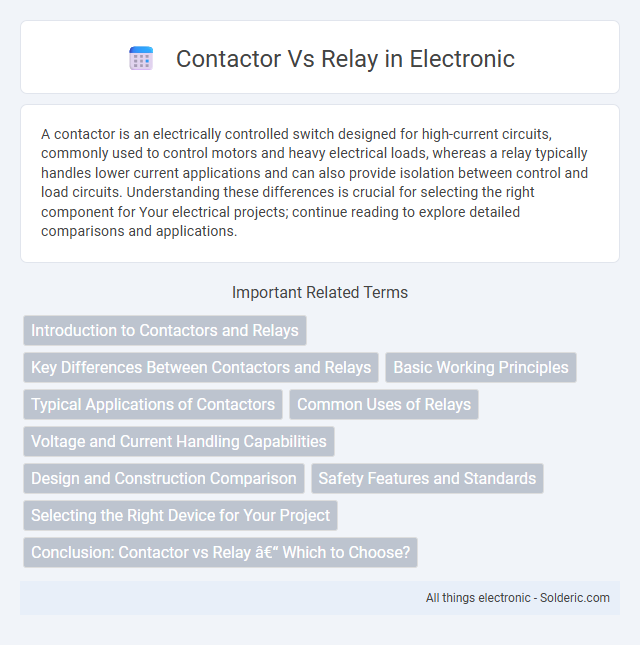A contactor is an electrically controlled switch designed for high-current circuits, commonly used to control motors and heavy electrical loads, whereas a relay typically handles lower current applications and can also provide isolation between control and load circuits. Understanding these differences is crucial for selecting the right component for Your electrical projects; continue reading to explore detailed comparisons and applications.
Comparison Table
| Feature | Contactor | Relay |
|---|---|---|
| Purpose | Switch high-power electrical loads | Switch low-power signals or control circuits |
| Current Rating | High (usually above 10A up to 1000A+) | Low to Medium (usually below 10A) |
| Application | Industrial motors, lighting, HVAC systems | Control circuits, logic functions, automation |
| Mechanical Durability | Designed for frequent switching with long life | Less durable under heavy switching loads |
| Size | Larger due to high power handling components | Smaller and compact design |
| Coil Voltage | Typically AC or DC, higher voltage ranges | Wide range, often low voltage DC |
| Contact Type | Usually NO (Normally Open) and NC (Normally Closed) contacts | Various contact configurations available |
| Cost | Higher cost due to robust construction | Generally lower cost |
Introduction to Contactors and Relays
Contactors and relays are essential electromagnetic switches used in electrical circuits to control power flow, with contactors typically handling higher current loads and relays designed for lower currents and signal switching. Your application's voltage and current requirements determine whether a contactor or relay is the best choice for efficient and safe operation. Understanding the operational differences, such as contactor's ability to manage heavy-duty motor control versus relay's role in precision circuit switching, ensures optimized electrical system performance.
Key Differences Between Contactors and Relays
Contactors and relays both serve as electrically operated switches but differ significantly in their design and application. Contactors are engineered for high-current circuits, commonly used in electric motor control and industrial machinery, while relays manage lower current signals for control and protection purposes. The key differences lie in their current capacity, coil voltage ranges, and intended use cases, with contactors offering robust performance for heavy loads and relays providing precise control for signal-level switching.
Basic Working Principles
Contactors operate by using an electromagnetic coil to create a magnetic field that pulls contacts together, enabling high-current devices to be switched on or off safely. Relays also use electromagnetic coils but are designed for switching lower currents and often serve to control circuits with different voltage levels or provide isolation. The key difference lies in their current capacity and application, with contactors suited for heavy-duty load control and relays for signal-level switching and control logic.
Typical Applications of Contactors
Contactors are commonly used in industrial and commercial electrical systems to control heavy-duty motors, lighting, heating equipment, and capacitor banks, handling higher current loads than relays. They facilitate safe and efficient switching of power circuits in automation systems, HVAC units, and large machinery, ensuring reliable operation under frequent switching conditions. Understanding the typical applications of contactors can help you choose the right device for managing high-power electrical loads in your projects.
Common Uses of Relays
Relays are commonly used in low-power applications such as switching small electrical loads, signal isolation, and controlling circuits in automation systems. They efficiently manage tasks like turning lights, alarms, and small motors on or off, often triggered by low voltage signals from microcontrollers or sensors. Your selection of a relay is crucial for ensuring reliable operation in electronics, HVAC systems, and automotive controls due to their precision and isolation capabilities.
Voltage and Current Handling Capabilities
Contactors are designed to handle higher voltage and current levels, typically used in industrial applications with loads exceeding 10 amps and voltages up to 600V or more. Relays are suited for lower voltage and current, generally managing up to 10 amps and control voltages below 250V, making them ideal for signal-level switching and low-power circuits. The robust construction of contactors ensures durability under heavy electrical loads, while relays prioritize precision and compactness for control tasks.
Design and Construction Comparison
Contactors are designed with robust contacts and coils to handle high electrical loads and frequent switching, making them suitable for industrial motor control and heavy-duty applications. Relays feature smaller, lighter components with lower current ratings, typically used for signal switching and control in low-power circuits. Your choice between a contactor and relay should consider the operational environment and current requirements to ensure optimal performance and longevity.
Safety Features and Standards
Contactors and relays comply with strict safety standards such as UL, IEC, and CSA to ensure reliable operation in electrical systems. Contactors are designed with robust insulation, arc suppression, and overload protection to handle high current loads safely, while relays typically feature isolation and fail-safe mechanisms to protect low voltage control circuits. Your choice should consider these safety features to maintain compliance and protect both equipment and personnel effectively.
Selecting the Right Device for Your Project
Selecting the right device between a contactor and a relay depends on factors such as load capacity, voltage requirements, and application purpose. Contactors are ideal for switching high-current loads like motors and industrial equipment, offering durability and performance under heavy-duty conditions. Relays suit low-power control circuits and signal switching, providing compact size and precise control for delicate electronics.
Conclusion: Contactor vs Relay – Which to Choose?
Choose a contactor for high-power applications requiring frequent switching and robust durability, as it handles higher loads and offers greater electrical isolation. Opt for a relay in low-power or signal-level circuits where compact size and faster response times are critical. Your decision should align with the specific voltage, current, and operational demands of your electrical system.
contactor vs relay Infographic

 solderic.com
solderic.com